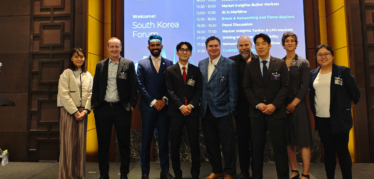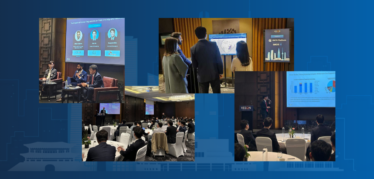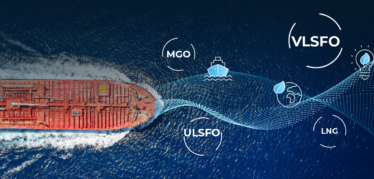With the first phase of EU ETS officially in effect, industry stakeholders across the shipping industry are facing unique challenges around how to incorporate this regulatory change into their maritime contracts. To shed light on navigating these complexities, we held a webinar panel discussion on Overcoming EU ETS Contract Challenges featuring maritime professionals at the forefront of industry discourse.

My colleague Josh Luby, Group Product Manager at Veson Nautical, was joined by Stinne Taiger Ivø, Deputy Secretary General at BIMCO, Lars Mathiasen, leading commercial decarbonization efforts at TORM, and Alan Cumming, Head of the Dry Freight Trading Desk at Trafigura in an intriguing discussion around new BIMCO clauses and how EU ETS is being addressed in their respective organizations. Together, the group offered nuanced perspectives from the standpoints of the industry, digital technology, and supporting associations on overcoming EU ETS maritime contract challenges and steering the industry towards sustainable horizons. In this blog, I will provide a summary of the key points covered during the webinar.
An Overview of BIMCO’s EU ETS Clauses
Stinne Taiger Ivø, Deputy Secretary General at BIMCO, provided valuable insights into the rationale behind BIMCO’s approach to EU ETS clauses. Stinne underscored the importance of addressing contractual challenges proactively, especially in light of the EU ETS directive’s implications for ship owners and charterers.
Stinne emphasized that the responsibility for EU ETS compliance primarily falls on shipowners. However, she highlighted the potential for charterers to seek reimbursement, as stipulated in the directive’s provisions. This highlights the need for clarity and alignment between owners and charterers regarding compliance obligations. Stinne explained, “having clauses that address EU ETS built in to your Charter Parties provides a clear understanding of who is responsible for what, regardless of the owner’s initial responsibility.”
BIMCO has responded to these challenges by developing several clauses tailored to address ETS compliance across different Charter Party scenarios. Stinne outlined key features of the Time Charter Parties clause, released by BIMCO in 2022, emphasizing the owner’s monitoring obligations and the charterer’s responsibility for allowance payment and transfer on a monthly basis.
She also detailed BIMCO’s Voyage Charter Party clauses, the first of which involves building the agreed upon cost into the freight to simplify and streamline agreements. Conversely, the next clause option keeps EU ETS costs separate from freight and includes it as a surcharge, which could be preferable for those wanting more transparency on cost breakdown. The final clause relates to situations where it is not a set cost that is agreed upon, but rather a set transfer of allowances. These clauses are designed to provide some flexibility – for example, for spot voyages it is up to the parties negotiating to agree on how to define a voyage and whether to include a ballast leg. “Regardless of the clauses you choose, all can help create some legal certainty, predictability, data accuracy, and commercial structure.” Stinne said.
Navigating Complexity and Compliance: Perspectives from Both Sides of the Contract
Much has changed since we last sat down with Alan Cumming of Trafigura and Lars Mathiasen of TORM over a year ago during the Managing Regulatory Complexity Panel Webinar. Catching up with them again in our most recent discussion, they provided valuable perspectives from both sides of the contract on how industry challenges and trends related to EU ETS are evolving.
Alan and Lars discussed the evolving landscape of contract structures and the adoption of BIMCO clauses within the industry. Lars commented that, from the owner perspective, they are currently observing “about 10-20 percent of people wish to pay financially basis actual consumption of EUAs, while the remaining 80-90 percent is equally split between an all-in arrangement or a surcharge arrangement.” Lars added, “of course, nothing is set in stone as to how this will develop, and it could very much depend on the freight market and geopolitical developments.” Both agreed that contractual clarity and predictability were highly important in navigating the complexities of EU ETS compliance.
Lars also shared an unexpected challenge that TORM encountered in their preparations leading up to EU ETS, recounting that they “initially thought the biggest obstacle would be purchasing and acquiring the EUAs, however this turned out to be fairly simple and straightforward.” Lars explained, “together with Veson, we have a strong tool to estimate our accumulating liability over the years, so we can top off our account accordingly. I would say the larger challenge has been the administrative financial accounting side of it, which has required a lot of discussion as we try to reach consensus with our auditors.”
Alan shared insights into the evolving dynamics of information sharing within the industry, noting a gradual shift towards greater transparency and collaboration that he’s witnessed from the commodity trader perspective. “When we first signed up to the Sea Cargo Charter and started asking questions to our counterparties about emissions, we received a large amount of pushback.” Alan recalled. “However, it’s becoming normalized now that it is a legal requirement, which is alleviating some prior apprehensions about the intention behind requesting information. Since the intention of understanding our own emissions footprint is known to all, people are getting accustomed to sharing more.” Further, Alan emphasized the importance of global regulation in driving meaningful change and addressing emissions tax evasion on a global scale.
A Comprehensive Solution for EU ETS Management
From a digital technology perspective, Veson’s Josh Luby pointed out the critical role of robust systems in managing EU ETS workflows effectively and keeping pace with industry changes – be it regulatory, contractual, or other. The IMOS Platform supports the entire lifecycle of a contract, from allowance settlement and expense accounting to contractual agreement changes and allowance transfers. By aligning Time Charter contracts with industry standards while offering flexibility for custom clauses, IMOS ensures seamless management of carbon costs. Further, IMOS facilitates accurate tracking of allowance transfers, maintaining an up-to-date inventory balance to support informed decision-making. Informed by ongoing industry input, we are committed to continual refinement and flexibility in meeting the dynamic and evolving demands of regulatory changes.
Want to hear the full conversation? Join hundreds of industry stakeholders who tuned in to this engaging discussion by accessing the Overcoming EU ETS Contract Challenges Webinar On-Demand.
In addition, Veson University is offering two EU ETS-specific courses that detail the regulation itself as well as how the IMOS Platform handles and supports your EU ETS workflows. This carries through the system from the first calculation of the estimated emissions through to the settlement and realization on the contracts and being able to support and handle all the various clauses. Visit Veson University to learn more about the courses and start standardizing continuous learning across your organization.



 Giftson Eliyesar
Giftson Eliyesar
 Hongbeom Park
Hongbeom Park
 Oliver Kirkham
Oliver Kirkham